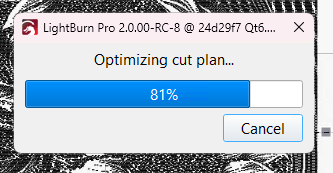In what format did you download the original file?
Do you mind posting the source..?
![]()
In addition to many small shapes could you be creating duplicate shapes to increase the file size? ![]()
No, I’ve checked that, there are only the shapes that make up the image, no duplicates.
The G-Code shows the Line Interval is 0.1 mm, because the Y axis moves are G1 Y0.0039 and G1 Y0.004 in G91 incremental mode.
I think that’s aggressive for a 64 W optical output diode laser combining a dozen beams into a single spot. The fact that the description doesn’t mention (let alone brag on) the spot size, suggests it’s larger than usual.
The tiny line interval may also contribute to the overall size mismatch, because the Y axis increments should be the same, but when rounded off to four places produce two different step sizes. That also affects the X axis step size, because LightBurn works with square pixels; there are plenty of adjacent X steps rounded differently.
Run an Interval test at whatever power level you’re using, as the spot size surely differs depending on how many lasers contribute to the beam. I think 0.2 mm = 8 mil would be a reasonable starting point.
The spot size is likely also different in the X and Y directions, because diode laser beams start out rectangular and get mashed into kinda-sorta squareness through optical brutality. This mostly works, but is worth checking:
I said “could you be creating duplicate shapes” but it is a translation error. I meant “could it be…” sorry.
![]()
everything is fine here ![]()
That sounds, as always from you, very understandable.
But the "problem with LightBurn is also new to me.
I just tested with a file consisting of about 100,000 short lines, LB didn’t like that either…
at 25,000 pieces it takes half a minute but LB can handle it
Your explanation make sense to me… ![]()
0.004 - 0.0039 = 0.0001 not 0.1 is my math right? ![]()
![]()
The G91 specifies incremental mode, so those commands move the head almost the same distance: 0.004 inch = 0.1 mm from its current location.
In G90 absolute mode, the commands would collapse the entire image into two lines, one at Y=0.0039 and the other at Y=0.004.
RC 8 stalled while optimizing all those tiny vectors:
Disabling optimizations (which probably makes sense anyway) got all the way to the goal in a few seconds, with the Preview looking just fine a few seconds later.
The NC file is GCode output from LightBurn, ready to run on a compatible controller - everything has been converted to small line segments.
If you import this file into LightBurn, it gets interpreted as geometry to run in Line mode - it has no idea how to get back the original outlines or images.
The user would need to post an LBRN or LBRN2 project file for you to be able to see what they see.
If you load the image they posted and just set that to run using one of the dither modes, you’ll likely end up with something close to what he posted.
Several sources
I am not. Just taking purchased file and setting it to the size and saving as gcode
I’m not sure I understand your explanation (the Portuguese translation confuses more than it clarifies)
But I got the idea that, according to my math, I missed an opportunity to keep quiet. ![]()
You’re (absolutely!) correct for G-code in G90 absolute mode.
It’s an easy mistake to make:
- In
G90absolute mode, the X coordinate = the position on the platform - In
G91incremental mode, the X coordinate = how far to move from where it is now
In G90 mode, all those G0 X0.004 commands would not move the head at all, because the first one would put it at X = 0.004 and the rest have the same coordinate. The G0 X0.0039 commands would move the head 0.0001 inch from the previous line at 0.004 inch, but we’d never notice.
However, the G-Code file starts with a G91, which means each G0 X0.004 moves the laser head that distance from its current location, so it scans a succession of lines separated by 0.004 inch (or 0.0039 inch).
Source: Been there, (absolutely!) made that mistake. ![]()
Explained this way, there is no way not to understand!
Thank you very much!
In my experience there is no better way to learn! ![]()
